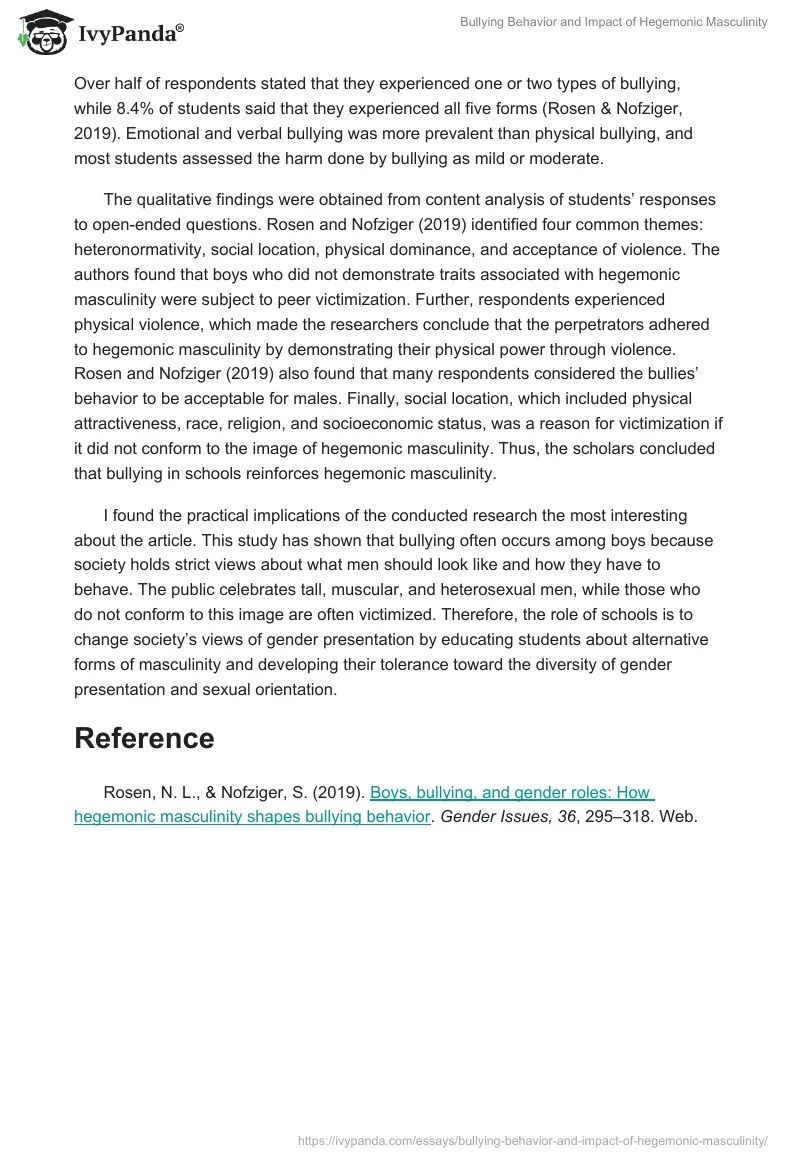The research conducted by Rosen and Nofziger (2019) aimed to investigate how bullying reinforced hegemonic masculinity. The authors’ main point is that schools are places where individuals develop behavioral patterns and world views; therefore, understanding schools’ role in gender socialization may provide insight into gender relationships in a larger society. Rosen and Nofziger (2019) chose bullying among boys as the subject of their analysis. According to the researchers, boys’ bullying experiences are influenced by societal expectations about masculinity. Rosen and Nofziger (2019) note that there are many types of masculinity, but among the existing alternatives, hegemonic masculinity is dominant. This is the type of masculinity that every man is expected to strive for, and it involves being muscular and tall, economically stable, and white.
Rosen and Nofziger (2019) utilized both qualitative and quantitative methods in their research. The scholars used secondary data from the Youth Voice Project, which was a national online survey of 13,177 students in 31 US schools designed to understand students’ bullying experiences. From this large data set, the authors selected 275 respondents that met inclusion criteria. The chosen students were boys studying in 6th-8th grades who experienced bullying at least two or three times a month and provided responses to open-ended questions. Rosen and Nofziger (2019) applied a quantitative research design to explore the relationships between students’ bullying experiences and race, age, and socioeconomic status and identify the frequency of bullying. The authors used a qualitative method of content analysis to find common themes in students’ bullying experiences, which would be related to hegemonic masculinity.
The authors’ quantitative findings identified bullying victims’ characteristics and experiences. In Rosen and Nofziger’s (2019) sample, poorer students were not more likely to be bullied than their peers. Students in special education programs were slightly more likely to be victims of bullying and accept violence. Regarding bullying experiences, name-calling was discovered to be the most common type, with 74% of respondents having experienced it (Rosen & Nofziger, 2019). Other prevalent forms of bullying included physical victimization, threats, spreading rumors, and being excluded. Over half of respondents stated that they experienced one or two types of bullying, while 8.4% of students said that they experienced all five forms (Rosen & Nofziger, 2019). Emotional and verbal bullying was more prevalent than physical bullying, and most students assessed the harm done by bullying as mild or moderate.
The qualitative findings were obtained from content analysis of students’ responses to open-ended questions. Rosen and Nofziger (2019) identified four common themes: heteronormativity, social location, physical dominance, and acceptance of violence. The authors found that boys who did not demonstrate traits associated with hegemonic masculinity were subject to peer victimization. Further, respondents experienced physical violence, which made the researchers conclude that the perpetrators adhered to hegemonic masculinity by demonstrating their physical power through violence. Rosen and Nofziger (2019) also found that many respondents considered the bullies’ behavior to be acceptable for males. Finally, social location, which included physical attractiveness, race, religion, and socioeconomic status, was a reason for victimization if it did not conform to the image of hegemonic masculinity. Thus, the scholars concluded that bullying in schools reinforces hegemonic masculinity.
I found the practical implications of the conducted research the most interesting about the article. This study has shown that bullying often occurs among boys because society holds strict views about what men should look like and how they have to behave. The public celebrates tall, muscular, and heterosexual men, while those who do not conform to this image are often victimized. Therefore, the role of schools is to change society’s views of gender presentation by educating students about alternative forms of masculinity and developing their tolerance toward the diversity of gender presentation and sexual orientation.
Reference
Rosen, N. L., & Nofziger, S. (2019). Boys, bullying, and gender roles: How hegemonic masculinity shapes bullying behavior. Gender Issues, 36, 295–318. Web.


